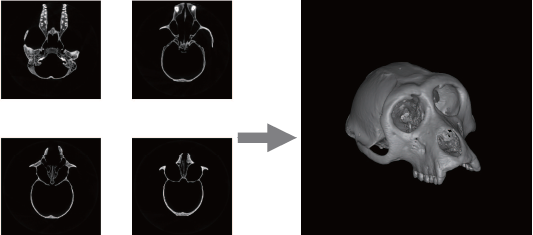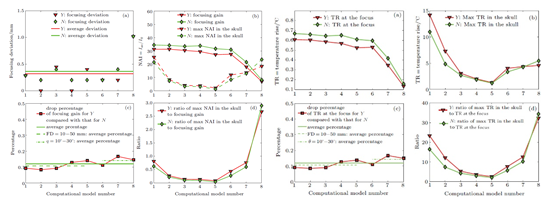Transcranial focused ultrasound (tcFUS) is a rapidly developing noninvasive technique for brain diseases with wide prospects of potential application in noninvasive treatment of intracranial tumors, neuro-modulations, treatment of neurological disorders, blood brain barrier opening, intracranial targeted drug delivery and so on.
Recently, by introducing the wave field separation method, WANG Xiangda, a doctoral student from the Institute of Acoustics (IOA) of the Chinese Academy of Sciences, along with his mentors and other researchers, numerically analyzed the effects of mode conversions between compressional and shear waves on transcranial focused ultrasound field and ultrasound-induced temperature field for the first time.
The paper entitled “Influence of Mode Conversions in the Skull on Transcranial Focused Ultrasound and Temperature Fields Utilizing the Wave Field Separation Method: A Numerical Study” was published in Chinese Physics B.

Figure 1. Reconstruction of three-dimensional skull model based on CT scans.(Image by IOA)
The skull is the biggest obstacle to the development of transcranial focused ultrasound and its clinical applications. The strong inhomogeneity of the skull leads to a focal shift or defocusing, whilst the great difference between the acoustic impedances of the skull and its surrounding media may result in overheating of the skull and its surrounding tissues.
The solutions to the two major problems of transcranial focused ultrasound induced by the skull rely on the modeling and simulation of transcranial focused ultrasound field. By modeling and simulating transcranial focused ultrasound field, the focal shift or defocusing can be corrected. Meanwhile, the overheating problem can also be monitored and suppressed as much as possible.
Traditional transcranial focused ultrasound modeling techniques and simulations mainly use acoustic wave equations in fluids without considering mode conversions in the skull between compressional and shear waves. In recent years, modeling techniques and simulations of transcranial focused ultrasound field including mode conversions have emerged and developed.
However, there is almost no research on the temperature field induced by transcranial focused ultrasound field.

Figure 2. Analysis of the influence of mode conversions on transcranial focused ultrasound and temperature fields.(Image by IOA)
By introducing the wave field separation method and establishing coupled simulators of transcranial focused ultrasound field and temperature field, WANG Xiangda and his team numerically analyzed the effects of mode conversions between compressional and shear waves on transcranial focused ultrasound field and ultrasound-induced temperature field for the first time.
Results showed that neglecting mode conversions lead to an underestimation of the acoustic energy deposited around the skull as well as an underestimation of the temperature rise in the skull. Meanwhile, both the focusing gain and the temperature rise at the focal region will be overestimated when mode conversions ignored. Besides, shear waves contribute a considerable portion of acoustic energy and temperature rise in the skull.
Funding for this research came from the National Natural Science Foundation of China (No. 81527901, No. 11604361, No. 91630309).
Reference:
WANG Xiangda, LIN Weijun, SU Chang, WANG Xiuming. Influence of Mode Conversions in the Skull on Transcranial Focused Ultrasound and Temperature Fields Utilizing the Wave Field Separation Method: A Numerical Study[J]. Chinese Physics B, 2018, 27(02):405-408. DOI: 10.1088/1674-1056/27/2/024302.
Contact:
WANG Rongquan
Institute of Acoustics, Chinese Academy of Sciences, 100190 Beijing, China
E-mail: wangrongquan@mail.ioa.ac.cn


